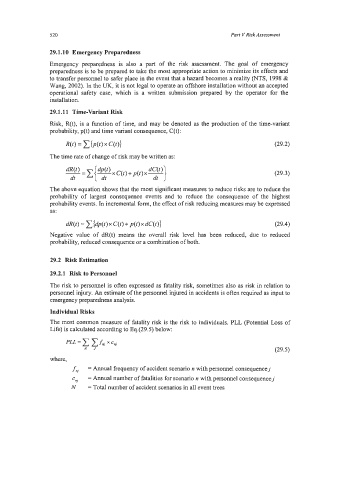Page 544 - Marine Structural Design
P. 544
520 Part V Risk Assessment
29.1.10 Emergency Preparedness
Emergency preparedness is also a part of the risk assessment. The goal of emergency
preparedness is to be prepared to take the most appropriate action to minimize its effects and
to transfer personnel to safer place in the event that a hazard becomes a reality (NTS, 1998 &
Wang, 2002). In the UK, it is not legal to operate an offshore installation without an accepted
operational safety case, which is a written submission prepared by the operator for the
installation.
29.1.11 Time-Variant Risk
Risk, R(t), is a function of time, and may be denoted as the production of the time-variant
probability, p(t) and time variant consequence, C(t):
(29.2)
The time rate of change of risk may be written as:
(29.3)
The above equation shows that the most significant measures to reduce risks are to reduce the
probability of largest consequence events and to reduce the consequence of the highest
probability events. In incremental form, the effect of risk reducing measures may be expressed
as :
dNt) = {dP(t)X C(t) + p(t) x dC(t)j (29.4)
Negative value of dR(t) means the overall risk level has been reduced, due to reduced
probability, reduced consequence or a combination of both.
29.2 Risk Estimation
29.2.1 Risk to Personnel
The risk to personnel is often expressed as fatality risk, sometimes also as risk in relation to
personnel injury. An estimate of the personnel injured in accidents is often required as input to
emergency preparedness analysis.
Individual Risks
The most common measure of fatality risk is the risk to individuals. PLL (Potential Loss of
Life) is calculated according to Eq.(29.5) below:
(29.5)
where,
f,. = Annual frequency of accident scenario n with personnel consequence j
cnj = Annual number of fatalities for scenario n with personnel consequencej
N = Total number of accident scenarios in all event trees

